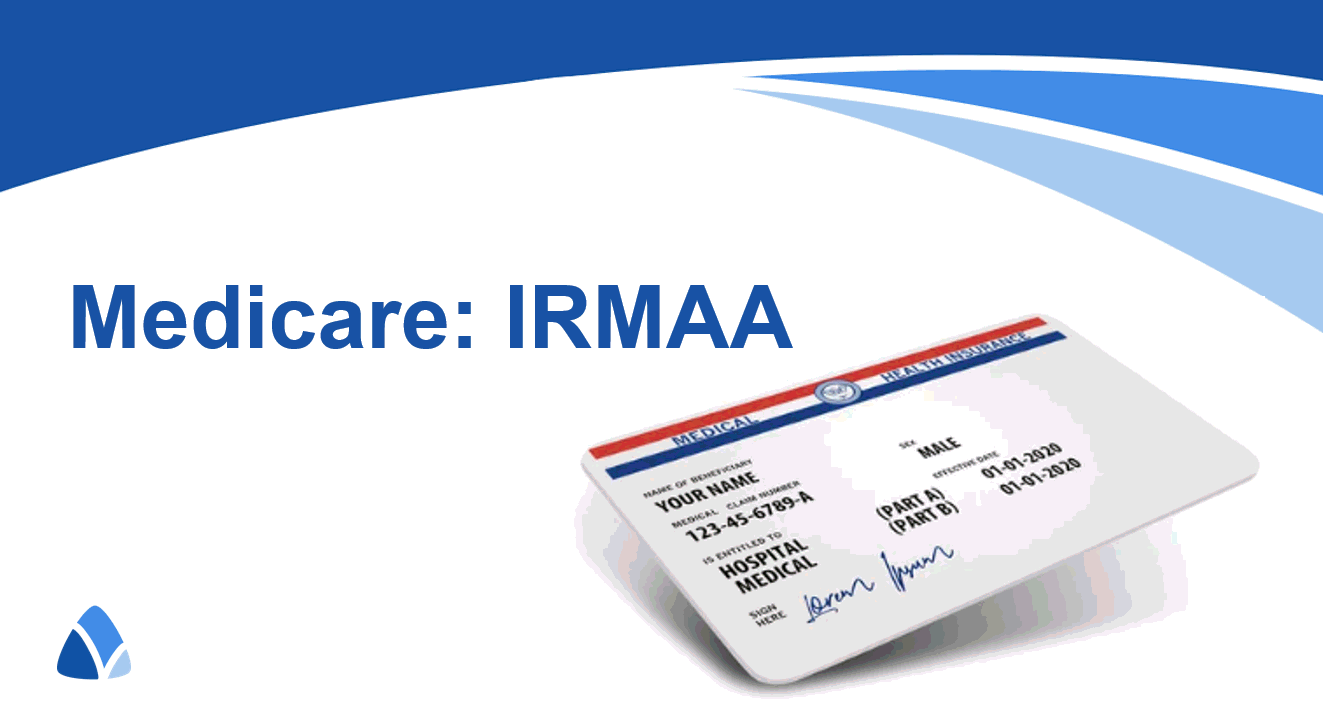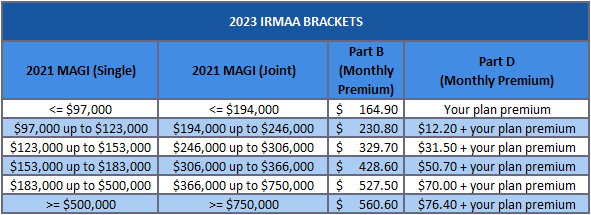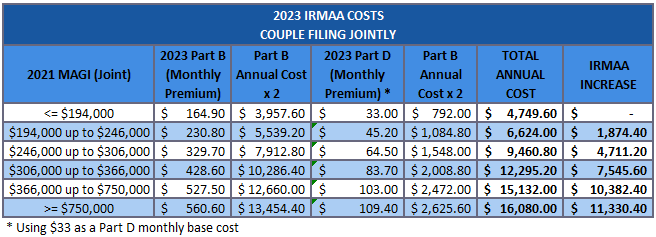MEDICARE: IRMAA
Feb 27, 2023 • Written by Paul Staib | Certified Financial Planner (CFP®), MBA, RICP®
Blog Home » Retirement Planning » MEDICARE: IRMAA

KEY TAKEWAYS
- IRMAA is tax surcharge that high-earning Medicare beneficiaries have to pay each month
- IRMAA is determined based on your Modified Adjusted Gross Income (MAGI) from your 2 years prior tax return (2023 IRMAA is based on your 2021 tax return)
- The Medicare Part B 2023 standard monthly premium is $164.90
- 2023 IRMAA brackets can increase monthly Medicare Part B premiums by as much as $395.70 and Medicare Part D premium by as much as $76.40 (per taxpayer)
- To appeal IRMAA, you will need to file form SSA-44
- Reducing your MAGI (modified adjusted gross income) will help you reduce, or even avoid, IRMAA in future years
- IRMAA should be a consideration, but not a driver, in determining an overall tax-efficient retirement income plan strategy
Retirees often find themselves in a high tax bracket during retirement once they begin collecting pensions, Social Security income and are subject to Required Minimum Distributions (RMDs). One of the downsides of this income, in addition to a higher tax bill, is getting hit with Medicare IRMAA.
OVERVIEW
IRMAA stands for “Income-Related Monthly Adjustment Amount.” It is an extra monthly charge that Medicare beneficiaries may have to pay for their Medicare Part B and Part D premiums if their income exceeds certain thresholds. Its purpose is to help fund the Medicare program, requiring higher income individuals to pay a larger amount of the program’s costs.
IRMAA HISTORY
- IRMAA was enacted in 2003 as part of the Medicare Modernization Act and the brackets were first implemented in 2007
- In 2011, the Affordable Care Act (ACA) expanded IRMAA to include higher income enrollees in Medicare Part D
- In 2018, the Bi-Partisan Budget Act created a 5th IRMAA bracket. The stipulation was that this new bracket would not be increased for inflation until at least 2028
- Since inception, IRMAA surcharges have grown steadily. The increases in the various IRMAA brackets have ranged from 4.7% to 8.0%
HOW IRMAA IS CALCULATED
Every year, the Social Security Administration (SSA) determines your IRMAA, if any, based on information from your income tax return from two years prior, which the SSA obtains from the IRS. If your modified adjusted gross income (MAGI) exceeds a certain threshold, you will have to pay an additional amount on top of your regular Medicare premium.
Unlike tax brackets, which are marginal, IRMAA utilizes a “cliff” style of assessment, meaning if you are just $1 over the cut off for the next tier of IRMAA, then you will pay the higher amount.

Also, it’s important to understand the IRMAA premium is per individual, so each spouse on Medicare will pay IRMAA (x2!), as estimated in the table below. As an example, if your 2021 joint MAGI was $194,001, IRMAA increased your combined annual cost by $1,874.40 ($6,624.00 – $4,749.60).

The SSA sends an annual notice of your Social Security benefits. In government speak that’s called an initial determination. You get notified by the SSA near the end of the current year (or when you initially apply for Medicare) if you’ll be required to pay an IRMAA for the following year. The IRMAA lasts for one year, and the SSA reevaluates your benefits again for the next year.
HOW TO APPEAL THE IRMAA
If you feel the IRMAA decision is incorrect, you have the right to appeal IRMAA.
To do so, contact the Social Security Administration to request that your initial IRMAA determination be reconsidered. This can be done over the phone by calling 800-772-1213 or in writing by filling out SSA-44.
To qualify for a change in IRMAA determination, you’ll need to show:
- your tax return was either inaccurate or out of date, or
- Your income has recently decreased significantly due to one of following life-changing events, as defined by the SSA:
- Marriage,
- Divorce or annulment of your marriage,
- Death of a spouse,
- You or your spouse stops working or reduce the number of hours your work,
- Loss of income from income-producing property, or
- Loss of pension income
NOTE: Single-year increases in taxable income from a non-qualifying life-changing event are NOT grounds for an IRMAA appeal. Common examples of one-time taxable income events which are not exempt from IRMAA include:
- Selling appreciated stock or other assets
- Roth conversions
- Selling the family home (to the extent the gains are not excluded by the capital gains exclusion of $250,000 for singles or $500,000 for married couples) or rental property
- Cashing out an annuity or life insurance contract worth more than the cost basis
Taxpayers considering generating taxable income should include any IRMAA surcharges as part of the consideration, albeit two years in the future.
AVOIDING (or REDUCING) IRMAA
There are several strategies which can be considered to reduce your MAGI and thereby reduce if not eliminate your IRMAA. These include:
- Charitable Giving: if you are charitable inclined, including Qualified Charitable Distributions (QCDs), Donor Advised Funds (DAFs), and gifting appreciated assets.
- Tax-Efficient Investments: utilizing a tax-efficient investment strategy can help reduce your MAGI and thereby minimize taxes. How you allocate and position (asset location) your investments within your investment accounts can be an important factor in reducing taxes.
- Tax-Efficient Withdrawal Strategies: in retirement, it’s critical to have a strategic and well informed long-term, tax-efficient withdrawal strategy which generates reliable income and is flexible to adjust to changing market and tax environments
- Roth Conversions: strategically executed Roth conversions (especially prior to RMD years) can provide significant reductions to a retiree’s lifetime tax burden, especially when significant tax-deferred assets (i.e. 401ks, traditional IRAs) are involved
THE BIG, LONG-TERM TAX PICTURE
- IRMAA should be a consideration, but not a primary driver, in determining an overall tax-efficient retirement income plan
- IRMAA brackets are separate and distinct from ordinary income tax brackets; they are not aligned. Both sets of brackets (along with other factors) should be considered when determining a prudent tax-efficient retirement income strategy
- IRMAA surcharges should be managed in conjunction with other taxes
- For taxpayers who have some control over their taxable income (perhaps prior to Social Security and RMDs), the best approach is usually to set taxable income slightly below the top of one of the IRMAA tiers
- Some IRMAA cost management approaches require planning, so future Medicare recipients should begin planning for the effects of IRMAA around age 60, or possibly even younger
It is important to build a tax-efficient retirement income plan not only on an annual basis, but also looking further into the future. A short-term strategy of avoiding IRMAA taxes may not be ideal when considering the lifetime tax implications of a long-term retirement plan.

Paul Staib | Certified Financial Planner (CFP®), MBA, RICP®
Paul Staib, Certified Financial Planner (CFP®), RICP®, is an independent Flat Fee-Only financial planner. Staib Financial Planning, LLC provides comprehensive financial planning, retirement planning, and investment management services to help clients in all financial situations achieve their personal financial goals. Staib Financial Planning, LLC serves clients as a fiduciary and never earns a commission of any kind. Our offices are located in the south Denver metro area, enabling us to conveniently serve clients in Highlands Ranch, Littleton, Lone Tree, Aurora, Parker, Denver Tech Center, Centennial, Castle Pines and surrounding communities. We also offer our services virtually.
Read Next
What’s In Your Credit Score
• Written By Paul Staib | Certified Financial Planner (CFP®), MBA, RICP®
Credit scoring has been in existence since the late 1950s, when it was first used by large retail stores and…
Four Criteria to Consider When Looking for a Financial Advisor
• Written By Paul Staib | Certified Financial Planner (CFP®), MBA, RICP®
When looking for a Financial Advisor to help achieve your personal financial goals you want to know they’re qualified and…
